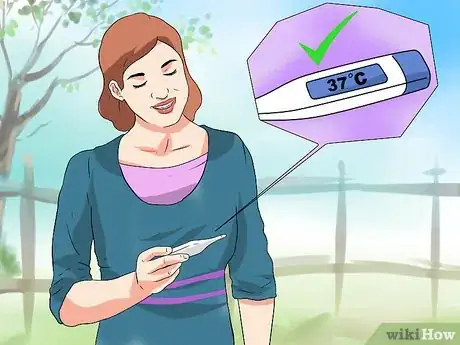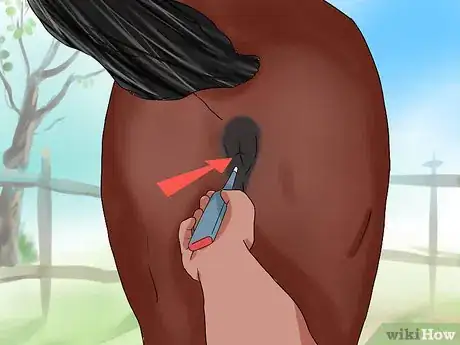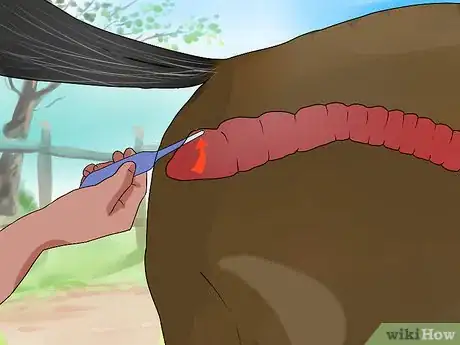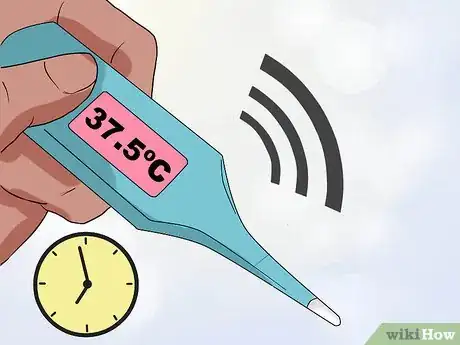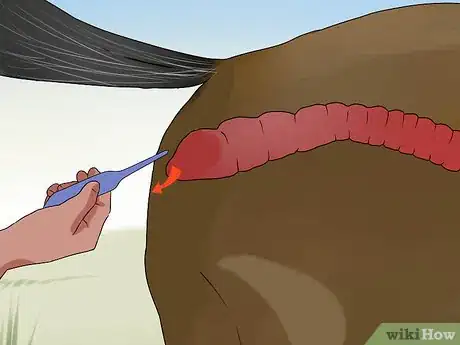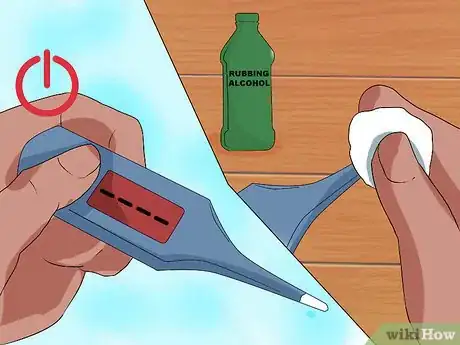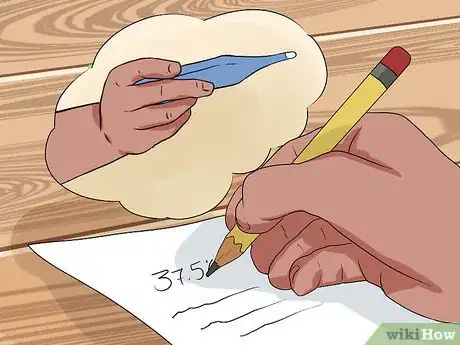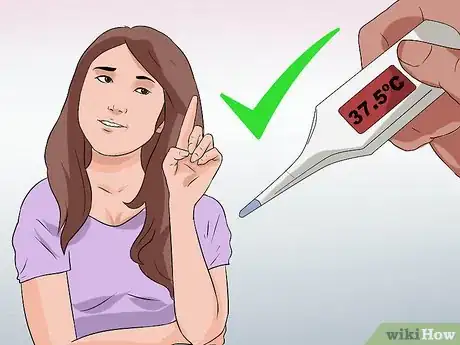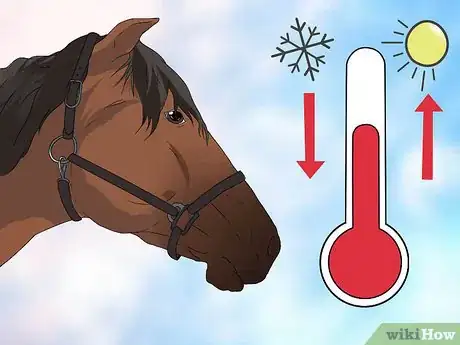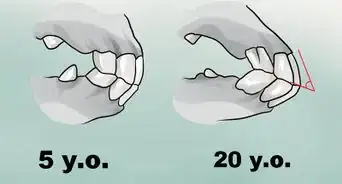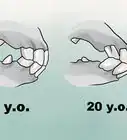This article was co-authored by Pippa Elliott, MRCVS. Dr. Elliott, BVMS, MRCVS is a veterinarian with over 30 years of experience in veterinary surgery and companion animal practice. She graduated from the University of Glasgow in 1987 with a degree in veterinary medicine and surgery. She has worked at the same animal clinic in her hometown for over 20 years.
This article has been viewed 107,856 times.
Being able to safely take a horse's temperature is a great asset for the owner. An elevated temperature can be an early warning sign that something is amiss, such as an infection or heat stroke. Knowing that your horse has a fever can help you make a decision as to whether you should call your veterinarian.
Steps
Preparing to Take the Horse’s Temperature
-
1Assemble your equipment. Make sure to gather your supplies beforehand, so that everything is ready when you need to take your horse’s temperature. These supplies include:
- Digital thermometer: A digital thermometer is best, as it will beep when the temperature becomes stable. It will also keep the temperature displayed in the display window for you to easily record the temperature if needed. Purchase a digital thermometer at your local drug store. This can be a regular “oral” or “rectal” thermometer, which are basically the same thing.[1] Dedicate this thermometer for use with your horse. If you are unable to get a digital thermometer, a mercury thermometer works just as well. Double check to make sure that it is clean and does not have any cracks, as this can be very dangerous for the horse.
- Gentle lubricant. You also need a gentle lubricant to ease the passing of the thermometer into the horse's rectum. Vaseline or KY Jelly is ideal. These products are readily available at grocery stores and drug stores.
- A pair of latex or rubber gloves.
- Cotton wool or tissue and rubbing alcohol.
-
2Wait until the horse has just had a bowel movement. It’s best to time taking a horse’s temperature for just after he has passed stool. This will reduce the possibility that you will insert the thermometer into dung. Dung registers a higher temperature reading and your reading will not accurately reflect the horse’s body temperature.
- Try feeding the horse or giving it a treat. This way, the horse will begin to trust you.
Advertisement -
3Interact with your horse. Usually, the owner of the horse will be the one taking the temperature. However, in instances where you may be taking care of a friend's horse or you're relatively new to first aid for horses, you need to become familiar with the horse. You also need to let the horse become familiar with you.
- Talk soothingly to your horse.
- Feed it a little treat, such as a carrot or apple.
- Scratch your horse’s nose or behind its ears.
-
4Tie up your horse securely. Ensure that the horse doesn't move around too much while you are taking his temperature. Tie him up to a wooden fence or post.
- Use a quick release knot so you can release him quickly if he gets spooked or agitated.
-
5Get someone to help you. A helper can hold the horse and talk soothingly to him as you take the temperature. This not only reduces the risk of getting kicked and/or trampled. It also means that you can concentrate on the job at hand while another person watches the horse's reactions and informs you of what the horse is doing.
-
6Check the digital display on the thermometer. If you are using a digital thermometer, switch it on. Make sure that the digital display appears in the display window. This will ensure that the thermometer is working correctly and that the battery is not dead. Wait until the digital display is flashing L (for low temperature reading). This will flash for approximately 10 seconds before registering a reading of a low or normal temperature.
- If you’re using a traditional mercury thermometer, shake it vigorously two or three times to make sure that the mercury has returned to the bulb prior to use. If you don’t take this step with a mercury thermometer, the mercury will read a previous "high" and you will get a false reading.
-
7Lubricate the thermometer. This is best done by dipping the bulb end (the end that inserts into the anus) with a blob of Vaseline or KY Jelly. Once this is done, you are ready to take the horse's temperature.
-
8Stand beside the horse on the mounting side. Prevent your horse from getting spooked by standing on the mounting side. Most horses are trained to be handled on the near side (for mounting, catching, etc).
-
9Approach the horse. Move toward the rear of the horse from the front at an angle. This allows the horse to see you, as horses have a blind spot directly behind him and directly in front of him. You will be much less likely to startle him if you come from an angle.
- Run one hand along the horse’s back, maintaining his attention and reassuring him that you are still there.
- Stand close to the horse's rump to avoid being kicked.
- Never under any circumstances stand directly behind the horse. If he kicks out, you could be seriously injured or even killed.
Taking the Temperature
-
1Grasp the tail with your left hand. As you stand with the horse’s rump to your left, you are facing towards the horse’s tail. Stroke the horse with your left hand (holding the thermometer in your right) and travel your hand down the horse's rump to the base of the tail. Gently grasp the tail base with your left hand and raise it sufficiently high to gain access to the anus.
-
2Insert the thermometer bulb into the anus. Peer around to get a good view, but without stepping behind the horse. Gently introduce the thermometer bulb into the anus.
- If the horse is "clenching," it helps to gently rotate the thermometer. This may help the thermometer to gently slide past the clenched muscles of the anus.
- Alternatively, wait a few seconds. Most horses don't clench their anal muscles for long, so once he relaxes, slide the thermometer right on in.
- You only need the bulb of the thermometer to be inside the anus. Do NOT slide the thermometer in beyond half the length of the thermometer neck. There is NO need to slide the whole of the thermometer into the rectum. This is how thermometers are lost internally!
- While some techniques advocate tying string to the thermometer in case of internal slippage, this is NOT advisable. If the thermometer goes entirely internal and swings around 90 degrees, pulling on the string could damage the rectum. It is equivalent to trying to get a ladder through a door when it is full width across the door frame. It's just not going to work. Instead, you are better advised to be cautious with how far you advance the thermometer.
-
3Keep talking to your horse. As you insert the thermometer, keep talking with your horse to reassure him. Many horses may not enjoy the sensation and they will benefit from a soothing voice.
-
4Have the thermometer tip resting against the rectal wall. Put slight pressure on the thermometer and push against the horse's near side (toward you). Don't do this too forcefully, just until there is a slight resistance. This will make sure that the tip of the thermometer rests against the rectal wall, not inside it.
- This is important so that the thermometer is not inserted into dung, as dung registers a higher temperature reading.
-
5Take the reading. A mercury thermometer will gradually increase, so you should wait until it has stopped increasing in temperature and is sitting at a constant temperature. A digital thermometer will beep when a reading has been established.
- This can take anywhere between 30 seconds and 2 minutes, depending on the time it takes for the temperature to become constant.
-
6Gently remove the thermometer. Take the thermometer out by gently pulling it out of the horse's bottom at the same angle it went in. Make sure that you don't flick or pull too fast during the removal of the thermometer, as this will pull the dry skin around the thermometer.
- If you were to slip or let the thermometer slip, you could possibly lose or drop the thermometer, or hurt the horse.
- Be aware that some horses will pass gas during this process, so you might want to hold your breath.
-
7Take the temperature again. If you suspect that the horse has an elevated temperature, repeat the procedure another one or two times. This will ensure that you get a mean temperature rather than just one measurement. Sometimes, variables such as dung and a stalling thermometer may affect your results.
-
8Disinfect the thermometer. Make sure the thermometer is turned off, or shaken down. Give the thermometer a good rub over with a disposable tissue or cotton wool. Soak a clean piece of cotton wool or tissue with rubbing alcohol and wipe it over the thermometer. This will disinfect the thermometer.
- Make sure to remove any manure which may have become attached to the thermometer.
-
9Take the temperature over 3-5 days. Track how your horse’s temperature reacts depending on time of day, weather, and other circumstances. For example, in the early morning, the temperature should be slightly lower, whereas at night or late afternoon, the temperature will likely read higher.
- If you take your horse’s temperature when he is not ill, then you’ll have a baseline temperature with which to compare abnormal temperatures.
Interpreting Your Temperature Results
-
1Record the result on a chart or in a diary. Make sure that you do this before you forget the temperature. If you jot down the temperature in a diary, you can track the temperature over some length of time.
-
2Know the normal body temperature of a horse. The average body temperature of a horse is 99 to 101 degrees Fahrenheit (37.5 degrees to 38.5 degrees Celsius).
-
3Consider your horse’s breed when interpreting the temperature. Your horse’s temperature may vary slightly depending on which breed of horse you own. There are three types of horses: cold-blood, warm-blood and hot-blood.[2] These designations don’t mean that your horse will have a drastically different body temperature from another horse, but there may be slight variations.
- Cold-blood: Native ponies, such as Welsh, Fjord, or Fell ponies, are better suited to cooler climates and naturally have slightly cooler body temperatures.
- Warm-blood: These horses are usually athletic with strength and stamina. Their body temperatures tend to run slightly higher. Examples include: Irish Draughts, Lipizzaners and Quarter Horses.
- Hot-blood: These horses are usually the most athletic horses. They are often used in long-distance riding and racing. Some examples include Arabs, Shagyas and Thoroughbreds.
- Keep in mind, however, that generally speaking, the normal range is from 99 to 101 degrees Fahrenheit, with anything above 101.5 to be seen as a possible infection.
-
4Consider the weather conditions. If the weather is extremely hot or extremely cold, your horse’s temperature may be slightly off one way or the other.
- In cold winter weather, a horse’s normal temperature shouldn’t be above about 100.5 degrees F.
- During the summer, a horse’s core temperature can raise up to 101 degrees F or more.
- Call your vet if the temperature is over 101.5 degrees F.[3]
-
5Take the horse’s activity into account. If your horse has been in an intense competition, such as a race or show, its temperature might be higher than normal. Some race horses can even have their core temperatures rise to 105 degrees F.
- You should call your vet if the temperature does not go down to the normal range within about 90 minutes.[4]
Knowing When to Call the Vet
-
1Call the vet if your horse’s temperature remains high. If you have taken your horse’s temperature a few times over the course of several hours or a few days, and it remains high, call the vet.
- Call your vet if the horse’s temperature remains above 101.5 degrees Fahrenheit.
-
2Call the vet if your horse has other symptoms. If your horse's temperature is above the normal range, and he has other symptoms, contact your veterinarian.
- Observe your horse and keep track of the other symptoms, such as loss of appetite or lack of energy.
-
3Call the vet if the thermometer slips internally. It is possible that the thermometer may slip entirely into the horse’s rectum. If this happens, call your veterinarian immediately.
- If the worst did happen and the thermometer slips internally, there is a chance it may be passed when the horse has a bowel movement. Call your veterinarian immediately, but monitor fecal output and check for the presence of the thermometer in the droppings. You can always cancel a vet visit if the thermometer comes out on its own.
Expert Q&A
-
QuestionIs it a sign of colic when a horse puts their nose to the ground?
 Pippa Elliott, MRCVSDr. Elliott, BVMS, MRCVS is a veterinarian with over 30 years of experience in veterinary surgery and companion animal practice. She graduated from the University of Glasgow in 1987 with a degree in veterinary medicine and surgery. She has worked at the same animal clinic in her hometown for over 20 years.
Pippa Elliott, MRCVSDr. Elliott, BVMS, MRCVS is a veterinarian with over 30 years of experience in veterinary surgery and companion animal practice. She graduated from the University of Glasgow in 1987 with a degree in veterinary medicine and surgery. She has worked at the same animal clinic in her hometown for over 20 years.
Veterinarian Some horses will hang their head when in pain or discomfort, but the most common reason is the horse is resting and relaxed. You need to interpret the head position as part of the bigger picture by looking at his ears (are they turned out to the side in a relaxed manner or flattened back as if tense and wary.) Are his hooves planted as if relaxed, or is he restless and constantly shifting his weight? By looking at the overall picture you will get a better idea if there is a problem or not.
Some horses will hang their head when in pain or discomfort, but the most common reason is the horse is resting and relaxed. You need to interpret the head position as part of the bigger picture by looking at his ears (are they turned out to the side in a relaxed manner or flattened back as if tense and wary.) Are his hooves planted as if relaxed, or is he restless and constantly shifting his weight? By looking at the overall picture you will get a better idea if there is a problem or not.
Warnings
- Never under any circumstances stand directly behind the horse. If he kicks out, you could be seriously injured or even killed.⧼thumbs_response⧽
References
About This Article
Before you take a horse’s temperature, make sure to coat the bulb end of the thermometer with petroleum jelly so that it slides in more easily. Then, stand to the left of your horse’s rump to avoid serious injury if your horse kicks its legs. Next, raise the tail and gently insert the bulb into the anus as you talk to your horse in a soothing voice. Once the thermometer beeps, gently remove it at the same angle as you pushed it in to prevent injuries to your horse’s rectal area. For more advice from our Veterinary reviewer, including how to interpret your horse’s temperature results, keep reading.





